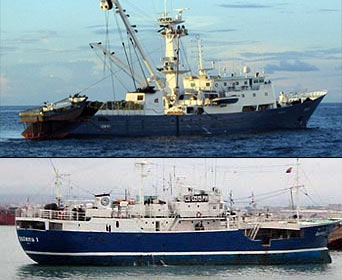|

A tuna purse seiner (above) an a longliner. (Photo: Stock File/CIAT/FIS)
The challenges of purse seine versus longline tuna fishing
 (WORLDWIDE, 5/10/2012)
(WORLDWIDE, 5/10/2012)
The tuna industry can be split into a sub-industry of high-priced fresh fish (particularly of sashimi) market mostly supported by longliners and one of low-priced canned tuna mainly supplied by purse seiners. As the demand for canned tuna has been expanding very rapidly, the purse seine fleet has also expanded rapidly, according to Dr Peter Miyake of the Organisation for the Promotion of Responsible Tuna Fisheries (OPRT).
It can be argued that purse seine fishing, particularly with fish aggregating device (FAD), is the most economic fishing method and uses the least fuel. But if companies were to catch all tuna only using purse seiners, the total catch which can be sustainable (MSY) would be much lower, and without a longline fishery, there would be no tuna available for sashimi consumption and the reduction in total economic yield would be considerable, he explained.
Purse seiners catch abundant relatively inexpensive young small-sized tuna, while longliners catch much less of very high-quality expensive large-sized fish.
A cohort of tuna gains mass until a certain size/age and thereafter mass will decline (i.e. natural mortality loss is greater than growth gain). This critical point is about 40 kg in yellowfin tuna and 70 kg in bigeye tuna, which correspond to captures by longliners.
Therefore, the total weight of fish which can be sustainably harvested by purse seiners alone would be much less than those caught only by longliners. In fact, the current maximum sustainable yield (MSY) of bigeye tuna taken by longline and a greater number of purse seine fisheries in the Pacific Ocean has been almost halved compared to the level 20 years ago when bigeye tuna were caught by longline alone, Miyake noted.
If only longline was used for catching tuna in order to increase MSY of bigeye, it would ease the pressure on the bigeye stock. For this to happen, a substantial increase in the number of longline vessels would be required, but even then catches may be lower than they are now, he clarified.
Another problem, Miyake explained, is that skipjack cannot be caught at all and yellowfin catches will also drop far below the MSY level. The canning industry will be devastated due to the severe shortage in tuna and the higher price of fish.
He concluded that the best alternative is to seek a point of compromise through a fair balance of social, economic, environmental and biological factors. Scientists must come up with an unbiased and transparent way to achieve a balance among these various factors, without being affected by prejudiced propaganda, money or political pressures.
Dr Peter Miyake is a leading tuna researcher who has worked for many international tuna fisheries management groups, including the Inter American Tropical Tuna Commission (IATTC) and the International Commission for the Conservation of Atlantic Tunas (ICCAT). He now participates in the scientific meetings as a visiting researcher at National Research Institute of Farseas Fisheries of Japan.
[email protected]
www.seafood.media
Information of the company:
|
Address:
|
Sankaido Bldg. (9th Floor) 1-9-13 Akasaka, Minato-ku
|
|
City:
|
Tokyo
|
|
State/ZIP:
|
(107-0052)
|
|
Country:
|
Japan
|
|
Phone:
|
+81 3 3568 6388
|
|
Fax:
|
+81 3 3568 6389
|
|
E-Mail:
|
[email protected]
|
More about: 
|
|
|



